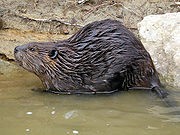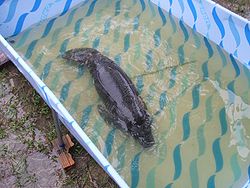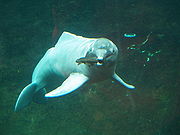
Aquatic mammal
Encyclopedia





_2560x1600.jpg)

Mammal
Mammals are members of a class of air-breathing vertebrate animals characterised by the possession of endothermy, hair, three middle ear bones, and mammary glands functional in mothers with young...
s that dwell partly or entirely in bodies of water
Body of water
A body of water or waterbody is any significant accumulation of water, usually covering the Earth or another planet. The term body of water most often refers to large accumulations of water, such as oceans, seas, and lakes, but it may also include smaller pools of water such as ponds, puddles or...
. They include the various marine mammal
Marine mammal
Marine mammals, which include seals, whales, dolphins, and walruses, form a diverse group of 128 species that rely on the ocean for their existence. They do not represent a distinct biological grouping, but rather are unified by their reliance on the marine environment for feeding. The level of...
s who dwell in ocean
Ocean
An ocean is a major body of saline water, and a principal component of the hydrosphere. Approximately 71% of the Earth's surface is covered by ocean, a continuous body of water that is customarily divided into several principal oceans and smaller seas.More than half of this area is over 3,000...
s, as well as various freshwater species, such as the Platypus
Platypus
The platypus is a semi-aquatic mammal endemic to eastern Australia, including Tasmania. Together with the four species of echidna, it is one of the five extant species of monotremes, the only mammals that lay eggs instead of giving birth to live young...
and the European Otter
European Otter
The European Otter , also known as the Eurasian otter, Eurasian river otter, common otter and Old World otter, is a European and Asian member of the Lutrinae or otter subfamily, and is typical of freshwater otters....
.
Groups
- This list covers only mammals that live in freshwaterFreshwaterFresh water is naturally occurring water on the Earth's surface in ice sheets, ice caps, glaciers, bogs, ponds, lakes, rivers and streams, and underground as groundwater in aquifers and underground streams. Fresh water is generally characterized by having low concentrations of dissolved salts and...
. For a list of saltwaterSeawaterSeawater is water from a sea or ocean. On average, seawater in the world's oceans has a salinity of about 3.5% . This means that every kilogram of seawater has approximately of dissolved salts . The average density of seawater at the ocean surface is 1.025 g/ml...
-living mammals, see Marine mammalMarine mammalMarine mammals, which include seals, whales, dolphins, and walruses, form a diverse group of 128 species that rely on the ocean for their existence. They do not represent a distinct biological grouping, but rather are unified by their reliance on the marine environment for feeding. The level of...
.- OrderOrder (biology)In scientific classification used in biology, the order is# a taxonomic rank used in the classification of organisms. Other well-known ranks are life, domain, kingdom, phylum, class, family, genus, and species, with order fitting in between class and family...
SireniaSireniaSirenia is an order of fully aquatic, herbivorous mammals that inhabit swamps, rivers, estuaries, marine wetlands, and coastal marine waters. Four species are living, in two families and genera. These are the dugong and manatees...
: Sirenians- family Trichechidae: manatees (3 species, however, the West Indian manateeWest Indian ManateeThe West Indian Manatee is a manatee, and the largest surviving member of the aquatic mammal order Sirenia . The West Indian Manatee, Trichechus manatus, is a species distinct from the Amazonian Manatee, T. inunguis, and the West African Manatee, T. senegalensis...
lives in saltwater)- Amazonian ManateeAmazonian ManateeThe Amazonian Manatee is a species of manatee that lives in the freshwater habitats of the Amazon basin. They are found in Brazil, Peru, Colombia, Ecuador, Guyana and Venezuela. Amazonian manatees are aquatic animals of the Sirenia order and are also known as "seacows". Their colour is grey but...
(Trichechus inunguis) - African ManateeAfrican ManateeThe African manatee , also known as the West African manatee or seacow, is a species of manatee and is the most endangered of the four species of sirenians. Scientists think they are most similar to West Indian manatees...
(Trichechus senegalensis) - Dwarf ManateeDwarf ManateeThe Dwarf Manatee is a possible species of manatee that lives in the freshwater habitats of the Amazon, though restricted to one tributary of the Aripuanã River...
(Trichechus "pygmaeus") (validity questionable)
- Amazonian Manatee
- family Trichechidae: manatees (3 species, however, the West Indian manatee
- Order CetaceaCetaceaThe order Cetacea includes the marine mammals commonly known as whales, dolphins, and porpoises. Cetus is Latin and is used in biological names to mean "whale"; its original meaning, "large sea animal", was more general. It comes from Ancient Greek , meaning "whale" or "any huge fish or sea...
: Cetaceans- Superfamily Platanistoidea
- Family Platanistidae
- Ganges and Indus River DolphinGanges and Indus River DolphinThe South Asian River Dolphin is a freshwater or river dolphin found in India, Nepal and Pakistan which is split into two sub-species, the Ganges River Dolphin and Indus River Dolphin...
, Platanista gangetica with two subspecies - Ganges River Dolphin (or Susu), Platanista gangetica gangetica
- Indus River DolphinIndus River dolphinThe Indus River dolphin is a sub-species of freshwater or river dolphin found in the Indus River of Pakistan...
(or Bhulan), Platanista gangetica minor
- Ganges and Indus River Dolphin
- Family Iniidae
- Amazon River Dolphin (or BotoBotoThe Amazon river dolphin, alternatively Bufeo, Bufeo Colorado, Boto Cor de Rosa, Boutu, Nay, Tonina, or Pink Dolphin , is a freshwater river dolphin endemic to the Orinoco, Amazon and Araguaia/Tocantins River systems of Brazil, Bolivia, Peru, Ecuador, Colombia and Venezuela...
), Inia geoffrensis
- Amazon River Dolphin (or Boto
- Family Platanistidae
- Family Lipotidae
- Chinese River Dolphin (or Baiji), Lipotes vexillifer (functionally extinct, since December 2006)
- Family Pontoporiidae
- La Plata DolphinLa Plata DolphinThe La Plata Dolphin or Franciscana is found in coastal Atlantic waters of southeastern South America. Taxonomically it is a member of the river dolphin group and the only one that actually lives in the ocean and saltwater estuaries, rather than inhabiting exclusively freshwater...
(or Franciscana), Pontoporia blainvillei
- La Plata Dolphin
- Superfamily Platanistoidea
- Order CarnivoraCarnivoraThe diverse order Carnivora |Latin]] carō "flesh", + vorāre "to devour") includes over 260 species of placental mammals. Its members are formally referred to as carnivorans, while the word "carnivore" can refer to any meat-eating animal...
- family MustelidaeMustelidaeMustelidae , commonly referred to as the weasel family, are a family of carnivorous mammals. Mustelids are diverse and the largest family in the order Carnivora, at least partly because in the past it has been a catch-all category for many early or poorly differentiated taxa...
- Genus LutraLutraLutra is a genus of otters.*Lutra nippon - Japanese otter*Lutra sumatrana - Hairy-nosed otter*Lutra lutra - European otter-Habitat:Lutra are semi-aquatic mammals and therefore need to be well-adapted to both water and land...
- Eurasian otter (Lutra lutra)
- Hairy-nosed otterHairy-nosed OtterThe Hairy-nosed Otter is one of the rarest otter species on earth. Until 1998, it was thought to have been extinct. However, since then small populations have been discovered.-Measurements:Weight: Head-body length: Tail length:...
(Lutra sumatrana)
- Genus Hydrictis
- Spotted-necked otter (Hydrictis maculicollis)
- Genus LutrogaleLutrogaleLutrogale is a genus of otter, with only one extant species - the smooth-coated otter.*† Lutrogale cretensis - Cretan Otter*† Lutrogale palaeoleptonyx*Lutrogale perspicillata - Smooth-coated Otter...
- Smooth-coated otterSmooth-coated OtterThe Smooth-coated Otter is a species of otter, the only extant representative of the genus Lutrogale. The species is found from southern Pakistan and parts of the India east to Southeast Asia, and there is a disjunct population in Iraq...
(Lutrogale perspicillata)
- Smooth-coated otter
- Genus LontraLontraLontra is a genus of otters from the American continent.The genus comprises four species:*North American River Otter *Southern River Otter *Neotropical Otter...
- North American River Otter (Lontra canadensis)
- Southern river otterSouthern River OtterThe Southern river otter is a species of otter that lives in Chile and Argentina. Although called a "river otter", it inhabits both marine and freshwater environments....
(Lontra provocax) - Neotropical river otterNeotropical River OtterThe Neotropical Otter , Lontra longicaudis, is an otter species found in Central America, South America and the island of Trinidad....
(Lontra longicaudis)
- Genus Pteronura
- Giant otterGiant OtterThe giant otter is a South American carnivorous mammal. It is the longest member of the Mustelidae, or weasel family, a globally successful group of predators. Unusually for a mustelid, the giant otter is a social species, with family groups typically supporting three to eight members...
(Pteronura brasiliensis)
- Giant otter
- Genus AonyxAonyxAonyx is a genus of otters, containing two species, the African Clawless Otter and the Oriental Small-clawed Otter. The word 'Aonyx' means 'clawless', derived from the prefix 'a-' and .-Species and subspecies:...
- African clawless otterAfrican Clawless OtterThe African clawless otter , also known as the cape clawless otter or groot otter, is the second largest freshwater species of otter. African clawless otters are found near permanent bodies of water in savannah and lowland forest areas...
(Aonyx capensis) - Oriental small-clawed otterOriental Small-clawed OtterThe oriental small-clawed otter , also known as Asian small-clawed otter, is the smallest otter species in the world, weighing less than 5 kg. It lives in mangrove swamps and freshwater wetlands of Bangladesh, Burma, India, southern China, Taiwan, Laos, Malaysia, Indonesia, the Philippines,...
(Aonyx cinerea)
- African clawless otter
- Genus Lutra
- family Phocidae
- Genus PusaPusaPusa is a genus of the earless seals, within the Family Phocidae. The three species of this genus were split from the genus Phoca, and some sources still give Phoca as an acceptable synonym for Pusa....
- Baikal seal (Pusa sibirica)
- Ladoga sealLadoga SealThe Ladoga ringed seal , is a freshwater subspecies of the ringed seal which are found entirely in Lake Ladoga in northwestern Russia. The subspecies evolved during the last ice age, about 11,000 years ago...
(Pusa hispida ladogensis) - Saimaa seal (Pusa hispida saimensis)
- Genus Pusa
- family Mustelidae
- Order Rodentia: Rodents
- Suborder HystricomorphaHystricomorphaThe term Hystricomorpha has had many definitions throughout its history. In the broadest sense it refers to any rodent with a hystricomorphous zygomasseteric system. This includes the Hystricognathi, Ctenodactylidae, Anomaluridae, and Pedetidae...
- CapybaraCapybaraThe capybara , also known as capivara in Portuguese, and capibara, chigüire in Venezuela, Colombia, and Ecuador ronsoco in Peru, chigüiro, and carpincho in Spanish, is the largest living rodent in the world. Its closest relatives are agouti, chinchillas, coyphillas, and guinea pigs...
(Hydrochoerus hydrochaeris)
- Capybara
- FamilyFamily (biology)In biological classification, family is* a taxonomic rank. Other well-known ranks are life, domain, kingdom, phylum, class, order, genus, and species, with family fitting between order and genus. As for the other well-known ranks, there is the option of an immediately lower rank, indicated by the...
CastoridaeCastoridaeThe family Castoridae contains the two living species of beaver and their fossil relatives. This was once a highly diverse group of rodents, but is now restricted to a single genus, Castor.- Characteristics :...
: Beavers- American BeaverAmerican BeaverThe North American Beaver is the only species of beaver in the Americas, native to North America and introduced to South America. In the United States and Canada, where no other species of beaver occurs, it is usually simply referred to as "beaver"...
(Castor canadensis) - European beaverEuropean BeaverThe Eurasian beaver or European beaver is a species of beaver, which was once widespread in Eurasia, where it was hunted to near extinction both for fur and for castoreum, a secretion of its scent gland believed to have medicinal properties...
(Castor fiber)
- American Beaver
- FamilyFamily (biology)In biological classification, family is* a taxonomic rank. Other well-known ranks are life, domain, kingdom, phylum, class, order, genus, and species, with family fitting between order and genus. As for the other well-known ranks, there is the option of an immediately lower rank, indicated by the...
CricetidaeCricetidaeThe Cricetidae are a family of rodents in the large and complex superfamily Muroidea. It includes true hamsters, voles, lemmings, and New World rats and mice...
- MuskratMuskratThe muskrat , the only species in genus Ondatra, is a medium-sized semi-aquatic rodent native to North America, and introduced in parts of Europe, Asia, and South America. The muskrat is found in wetlands and is a very successful animal over a wide range of climates and habitats...
(Ondatra zibethicus)
- Muskrat
- FamilyFamily (biology)In biological classification, family is* a taxonomic rank. Other well-known ranks are life, domain, kingdom, phylum, class, order, genus, and species, with family fitting between order and genus. As for the other well-known ranks, there is the option of an immediately lower rank, indicated by the...
Myocastoridae- CoypuCoypuThe coypu , , also known as the river rat, and nutria, is a large, herbivorous, semiaquatic rodent and the only member of the family Myocastoridae. Originally native to subtropical and temperate South America, it has since been introduced to North America, Europe, Asia, and Africa, primarily by...
(Myocastor coypus)
- Coypu
- FamilyFamily (biology)In biological classification, family is* a taxonomic rank. Other well-known ranks are life, domain, kingdom, phylum, class, order, genus, and species, with family fitting between order and genus. As for the other well-known ranks, there is the option of an immediately lower rank, indicated by the...
CricetidaeCricetidaeThe Cricetidae are a family of rodents in the large and complex superfamily Muroidea. It includes true hamsters, voles, lemmings, and New World rats and mice...
- European Water Vole (Arvicola amphibius)
- Suborder Hystricomorpha
- OrderOrder (biology)In scientific classification used in biology, the order is# a taxonomic rank used in the classification of organisms. Other well-known ranks are life, domain, kingdom, phylum, class, family, genus, and species, with order fitting in between class and family...
Monotremata: Monotremes- PlatypusPlatypusThe platypus is a semi-aquatic mammal endemic to eastern Australia, including Tasmania. Together with the four species of echidna, it is one of the five extant species of monotremes, the only mammals that lay eggs instead of giving birth to live young...
(Ornithorhynchus anatinus)
- Platypus
- Order Artiodactyla: Even-toed ungulates
- Family HippopotamidaeHippopotamidaeHippopotamuses are the members of the family Hippopotamidae. They are the only extant artiodactyls which walk on four toes on each foot.- Characteristics :...
: Hippopotamuses- HippopotamusHippopotamusThe hippopotamus , or hippo, from the ancient Greek for "river horse" , is a large, mostly herbivorous mammal in sub-Saharan Africa, and one of only two extant species in the family Hippopotamidae After the elephant and rhinoceros, the hippopotamus is the third largest land mammal and the heaviest...
(Hippopotamus amphibius) - Pygmy hippopotamusPygmy HippopotamusThe pygmy hippopotamus is a large mammal native to the forests and swamps of western Africa . The pygmy hippo is reclusive and nocturnal...
(Choeropsis liberiensis)
- Hippopotamus
- Family Hippopotamidae
- Order AfrosoricidaAfrosoricidaThe order Afrosoricida contains the golden moles of southern Africa and the tenrecs of Madagascar and Africa, two families of small mammals that have traditionally been considered to be a part of the order Insectivora.Some biologists use Tenrecomorpha as the name for the tenrec-golden mole clade,...
- Giant Otter ShrewGiant Otter ShrewThe Giant Otter Shrew is a semiaquatic, carnivorous tenrec. It is found in the main rainforestblock of Central Africa from Biafra to Zambia, with a few isolated populations in Kenya and Uganda. It is found in streams, wetlands, and slowly flowing larger rivers...
(Potamogale velox)
- Giant Otter Shrew
- Order SoricomorphaSoricomorphaThe order Soricomorpha is taxon within the class of mammals. In previous years it formed a significant group within the former order Insectivora...
- Russian DesmanRussian DesmanThe Russian Desman is a small semi-aquatic mammal that inhabits the Volga, Don and Ural River basins in Russia, Ukraine and Kazakhstan. It constructs burrows into the banks of ponds and slow-moving streams, but prefers small, overgrown ponds with abundance of insects, crayfish and amphibians...
(Desmana moschata)
- Russian Desman
- Order DidelphimorphiaDidelphimorphiaOpossums make up the largest order of marsupials in the Western Hemisphere, including 103 or more species in 19 genera. They are also commonly called possums, though that term technically refers to Australian fauna of the suborder Phalangeriformes. The Virginia opossum was the first animal to be...
: Opossums- Family Didelphidae: Opossums
- Yapok (Chironectes minimus)
- Family Didelphidae: Opossums
- Order
See also
- Aquatic animalAquatic animalAn aquatic animal is an animal, either vertebrate or invertebrate, which lives in water for most or all of its life. It may breathe air or extract its oxygen from that dissolved in water through specialised organs called gills, or directly through its skin. Natural environments and the animals that...
- List of semiaquatic organisms
- Marine mammalMarine mammalMarine mammals, which include seals, whales, dolphins, and walruses, form a diverse group of 128 species that rely on the ocean for their existence. They do not represent a distinct biological grouping, but rather are unified by their reliance on the marine environment for feeding. The level of...

